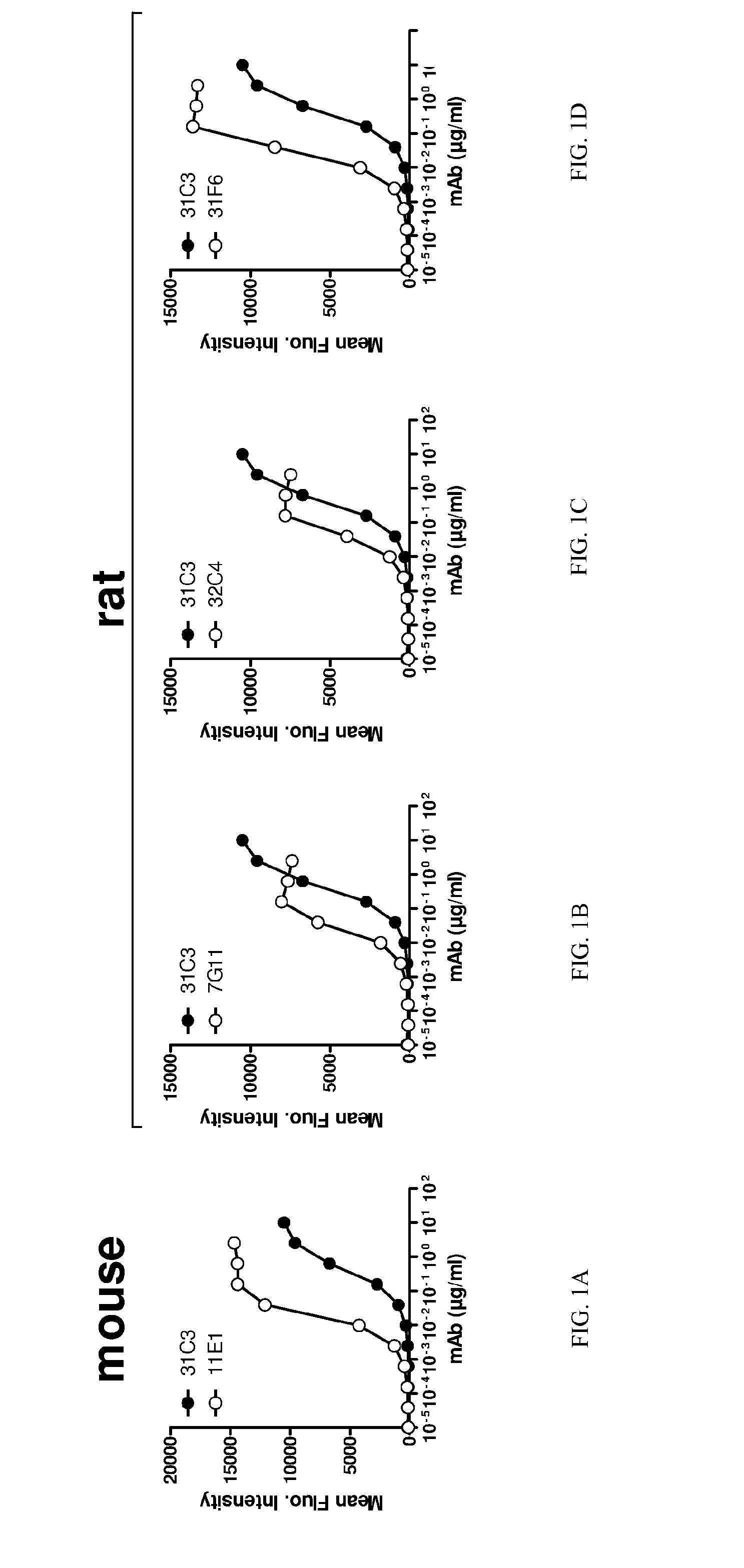Tlr3 binding agents
a technology of binding agents and tlr3, which is applied in the field of antibodies, can solve the problem that little remains known about the mechanism
- Summary
- Abstract
- Description
- Claims
- Application Information
AI Technical Summary
Benefits of technology
Problems solved by technology
Method used
Image
Examples
example 1
Generation of TLR3-Specific Monoclonal Mouse and Rat Anti-Human Antibodies
[0316]A series of immunization were carried out in order to generate different antibodies that block human TLR3 with improved efficacy over previous antibodies. The primary and secondary screens were as follows.
[0317]Immunization #1.
[0318]Primary screen. To obtain anti-human TLR3 antibodies, Balb / c mice (3 animals) were immunized with a recombinant human His-tagged TLR3 extracellular domain recombinant protein (R&D systems, #1487-TR-050). Mice were immunized, spleen cells were fused and cultured in the presence of irradiated spleen cells. Mice received one primo-immunisation with an emulsion of 50 μg TLR3 protein and Complete Freund Adjuvant, intraperitoneally, a 2nd immunization with an emulsion of 50 μg TLR3 protein and Incomplete Freund Adjuvant, intraperitoneally, and a boost with 10 μg TLR3 protein, intravenously. Hybridomas were plated into culture plates and supernatants (SN) were evaluated in a first s...
example 2
Generation of TLR3-Specific Monoclonal Rat Anti-Mouse Antibodies
[0326]Primary screen. To obtain anti-TLR3 antibodies, LOU / c rats were immunized with a recombinant His-tagged mouse TLR3, carrier free extracellular domain recombinant protein (R&D systems, #3005-TR) and recombinant His-tagged human TLR3, carrier free extracellular domain recombinant protein (R&D systems, #1487-TR). Rats received, on day 0, one primo-immunisation with an emulsion of 50 μg of mouse TLR3+50 μg of human TLR3 diluted in PBS and Complete Freund Adjuvant, intraperitoneally, a 2nd immunization on day 14 with an emulsion of 50 μg of mouse TLR3+50 μg of human TLR3 diluted in PBS and Incomplete Freund Adjuvant, intraperitoneally, and one boost with 25 μg of mouse TLR3+25 μg of human TLR3 diluted in PBS, intravenously. Immune spleen cells were fused with X63.Ag8.653 immortalized B cells, and cultured in the presence of irradiated spleen cells.
[0327]40 culture plates were obtained and evaluated in a first screen fo...
example 3
Binding to Cell Surface TLR3
[0330]To investigate the possibility that TLR3 is cycled to the cell surface and that cell surface TLR3 contributes to internalization and efficacy of inhibitory anti-TLR3 antibodies, binding to cell surface TLR3 was tested, in comparison to reference antibody 31C3. Additionally, binding (e.g. affinity) to cell surface TLR3 at neutral pH may differ from that of endosomally-expressed TLR3 at acidic pH. Antibodies were tested for binding to cells expressing human TLR3 solely at the cell surface (TLR3 / CD32-expressing 293T cells), at neutral pH conditions since pH could potentially affect TLR3 conformation. Results for neutral pH are shown in FIGS. 1A, 1B, 1C and 1D for antibodies 11E1, 7G11, 32C4 and 31F6, respectively. EC50 values are shown in Table 6. Antibodies 11E1, 7G11, 31F6 and 32C4 each had strong binding to surface-expressed human TLR3 at neutral pH. Affinity of the antibodies for TLR3 was stronger than reference antibody 31C3 at neutral pH.
TABLE 6m...
PUM
| Property | Measurement | Unit |
|---|---|---|
| Time | aaaaa | aaaaa |
| Mass | aaaaa | aaaaa |
| Mass | aaaaa | aaaaa |
Abstract
Description
Claims
Application Information
 Login to View More
Login to View More - R&D
- Intellectual Property
- Life Sciences
- Materials
- Tech Scout
- Unparalleled Data Quality
- Higher Quality Content
- 60% Fewer Hallucinations
Browse by: Latest US Patents, China's latest patents, Technical Efficacy Thesaurus, Application Domain, Technology Topic, Popular Technical Reports.
© 2025 PatSnap. All rights reserved.Legal|Privacy policy|Modern Slavery Act Transparency Statement|Sitemap|About US| Contact US: help@patsnap.com



